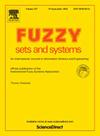Discernibility matrix-based feature selection approaches with fuzzy dominance-based neighborhood rough sets
IF 3.2
1区 数学
Q2 COMPUTER SCIENCE, THEORY & METHODS
引用次数: 0
Abstract
Monotonic classification tasks (MCTs) are a critical type of classification tasks, characterized by the monotonic constraints between features and decision. As an essential dimensionality reduction technique, feature selection using discernibility matrices (DMs) has gained considerable attention. Relevant studies in MCTs have effectively addressed the construction of DMs, followed by the reduct computation via the discernibility function method. However, they remain restricted within crisp dominance rough sets (DRSs) and overlook other potential usages of DMs in feature selection. To address these issues, this paper constructs a DM based on a fuzzy DRS model and combines it with feature grouping to propose a composite feature selection algorithm for MCTs, termed DMCD. Firstly, fuzzy dominance-based neighborhood rough sets are established as the theoretical foundation, and a DM corresponding to fuzzy rank dependency is constructed. The discernibility function method can thus be employed to calculate all the reducts. Next, we use the DM to quantify the discriminative power of features and design a fuzzy-rank-entropy-based distance measure, which is then employed to group features with similar classification information. At each iteration of DMCD, the most discriminative features carrying distinct classification information are selected from these groups and sequenced. After this procedure, a wrapper technique is applied to derive the optimal feature subset. Finally, experiments on twenty real datasets demonstrate the robustness of the FDNRS model and the effectiveness of the DMCD algorithm.
基于分辨矩阵的模糊优势邻域粗糙集特征选择方法
单调分类任务(Monotonic classification task, mct)是一类重要的分类任务,其特点是特征与决策之间存在单调约束。作为一种重要的降维技术,利用可分辨矩阵进行特征选择已经引起了人们的广泛关注。mct的相关研究已经有效地解决了dm的构造问题,然后通过可辨函数法进行约简计算。然而,它们仍然局限于清晰的优势粗糙集(drs),而忽略了dm在特征选择中的其他潜在用途。为了解决这些问题,本文在模糊DRS模型的基础上构建了一种基于模糊DRS模型的特征选择算法,并将其与特征分组相结合,提出了一种针对mct的复合特征选择算法,称为DMCD。首先,建立了基于模糊优势度的邻域粗糙集作为理论基础,构造了与模糊等级依赖相对应的DM;因此,差别函数法可以用来计算所有的约简。接下来,我们使用DM来量化特征的判别能力,并设计一个基于模糊等级熵的距离度量,然后将具有相似分类信息的特征分组。在DMCD的每次迭代中,从这些组中选择携带不同分类信息的最具判别性的特征并进行测序。在此过程之后,应用包装技术推导出最优特征子集。最后,在20个实际数据集上进行了实验,验证了FDNRS模型的鲁棒性和DMCD算法的有效性。
本文章由计算机程序翻译,如有差异,请以英文原文为准。
求助全文
约1分钟内获得全文
求助全文
来源期刊

Fuzzy Sets and Systems
数学-计算机:理论方法
CiteScore
6.50
自引率
17.90%
发文量
321
审稿时长
6.1 months
期刊介绍:
Since its launching in 1978, the journal Fuzzy Sets and Systems has been devoted to the international advancement of the theory and application of fuzzy sets and systems. The theory of fuzzy sets now encompasses a well organized corpus of basic notions including (and not restricted to) aggregation operations, a generalized theory of relations, specific measures of information content, a calculus of fuzzy numbers. Fuzzy sets are also the cornerstone of a non-additive uncertainty theory, namely possibility theory, and of a versatile tool for both linguistic and numerical modeling: fuzzy rule-based systems. Numerous works now combine fuzzy concepts with other scientific disciplines as well as modern technologies.
In mathematics fuzzy sets have triggered new research topics in connection with category theory, topology, algebra, analysis. Fuzzy sets are also part of a recent trend in the study of generalized measures and integrals, and are combined with statistical methods. Furthermore, fuzzy sets have strong logical underpinnings in the tradition of many-valued logics.
 求助内容:
求助内容: 应助结果提醒方式:
应助结果提醒方式:


